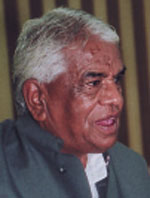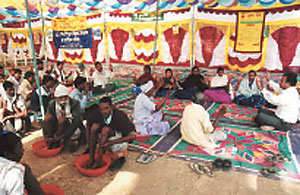|
AMBASSADOR'S JOURNAL
The Fight Continues
Efforts to eliminate leprosy continue to make progress. The battle against social discrimination must do the same.
THE PHILIPPINES (DECEMBER 1-2, 2004)
In December 2004, I attended WHO's SEARO/WPRO bi-regional meeting in Manila on post-elimination strategies in South East Asia and the Western Pacific. The theme of the meeting was how to sustain elimination once the goal of achieving a prevalence rate of less than 1 per 10,000 population has been achieved. In particular, the strategy focuses on establishing a surveillance system, integrating treatment of leprosy into the general health services and ensuring early detection and treatment.
INDIA (DECEMBER 3-9)
Eliminating leprosy and rooting out stigma and social discrimination are two sides of the same coin. To win the battle against leprosy, it is necessary to address both. Visiting the Indian states of Madhya Pradesh and Andhra Pradesh only strengthened this conviction.
I have visited India repeatedly in recent years. Of all the countries that have yet to achieve elimination, India has the most cases (266,000 at the end of March 2004). This was my tenth visit since 2003, but my first to these states.
Both states are working toward the elimination goal. As of October 2004, Madhya Pradesh had a PR of 1.28/10,000, and Andhra Pradesh of 1.73/10,000. Elimination is close.
Furthermore, in Madhya Pradesh, there are camps to assist in the process of reintegrating cured persons into society. Known in Hindi as Kushta Kantha Nivaram Karykram (literally, “camps to remove the suffering of recovered persons from within”), they bring together those recovered from the disease as well as community members in a move to tackle stigma and social discrimination.
Meanwhile, in Andhra Pradesh, efforts are being made to integrate leprosy into the general health services, where it can be treated as just one more disease.
 Shri Babulal Gaur, chief minister, Madhya Pradesh
Shri Sushil Kumar Shinde, governor, Andhra Pradesh
Malak Singh Shrivastav
In Bhopal, I met with Dr. Balram Jakhad, the governor of Madhya Pradesh; Shri Babulal Gaur, the chief minister; Dr. Gaurishankar Shejwar, the health minister; and Dr. M.K. Joshi, the health department director and secretary for state leprosy eradication. In Hyderabad, I called on Shri Sushil Kumar Shinde, the governor of Andhra Pradesh and attended ILEP's India Day meeting and an Adovacy Meet organized by LEPRA where the speakers included Dr. T.V. Venkateswarulu, AP's state leprosy officer.
I also visited with patients, recovered persons and health workers to hear their stories. Of all the people I encountered, I shall not forget Mr. Malak Singh Shrivastav, whom I met in Bhopal. A 56-year-old farmer from the village of Maleh Pipariya, Narsinghpur District, he was diagnosed with leprosy three years ago. Based on the little he knew, he thought this would result in him being shunned by society.
For two days, he couldn't eat, and on the third day, he began to think about killing himself. He told a close friend, and as soon as his family and fellow villagers got to hear of this, they watched over him 24 hours a day for 15 days to make sure he didn't follow through on his suicide plan.
Meanwhile, his wife went to the regional leprosy officer for more information, and convinced her husband that the disease was easily treatable, medicine was available at the primary health center, and that nobody was going to exclude him from society. Thus encouraged, and at the same time moved by the compassion of his family and friends, he began receiving treatment and was completely cured. In all that time, the only stigma he suffered was in his own heart.
As a result of his experiences, Mr. Shrivastav was moved to fund a Kushta Kantha Nivaram Karkyram camp in his district. Known in English as a Care and Concern Camp, it helps to reduce the physical and mental suffering of those with leprosy. Since 2003, he has organized three such camps from his own home, at which those who have lost feeling in their hands and feet receive treatment for injuries, and are given a warm welcome by the local community. He also appears before the media to tell his story.
 Care and Concern Camp in Sanchi, Madhya Pradesh
Every word uttered by a recovered person is ten times more persuasive than anything I might say.
I have always felt that the most effective way to rid society of stigma and discrimination is for recovered persons to come together and lead the fight. Every word uttered by a recovered person is ten times more persuasive than anything I might say. In Mr. Shrivastrav's case, he is not merely speaking up but extending a hand to patients and recovered persons. I am inspired by his example.
Listening to his story, I was reminded of the words of Mahatma Gandhi: “Leprosy work is not merely medical relief, it is transforming frustration in life into the joy of dedication, personal ambition into selfless service.”
WHO's Dr. Derek Lobo addresses the Advocacy Meet in Hyderabad.
While in Hyderabad, I visited the Uppal Public Health Center in Ranga Reddy District. There I met about 20 leprosy patients as well as some 40 student nurses from the Yashoda School of Nursing and the Kamineni School of Nursing. As the student nurses and PHC workers looked on, I handed out MDT from blister packs to the 20 or so patients ― ranging in age from children to adults ― who swallowed their dose in front of us as if taking cold medicine. It reinforced the impression that leprosy is just another curable disease, and this is something that I hope will stay in the minds of those student nurses when they have occasion to meet leprosy patients in future.
Elsewhere in Ranga Reddy District, I visited the Sivananda Rehabilitation Home, which proved to be another unforgettable experience. It was started in 1958 as a rehabilitation facility for those with leprosy. At present, it is home to some 500 recovered persons, including some with families.
Scene from Sivananda Rehabilitation Home
The facility includes a school for residents' children, a hospital for basic reconstructive surgery and rehabilitation, and workshops for spinning, weaving and shoe manufacture.
I went from dwelling to dwelling and met about 200 recovered persons, shaking hands with each. The experience brought home the importance of early diagnosis and treatment, since it was apparent that even if social discrimination were to disappear, it would still be difficult for those with severe disabilities to be socially reintegrated. For this to happen, everybody needs to know that leprosy is curable, treatment is free and that they won't face discrimination. At the same time, it is essential that treatment of leprosy is integrated within the general health services.
Even though leprosy is curable, only when people have early access to treatment will it be possible to do away with such colonies. I am resolved to continue the fight so that those who have been treated can live normal lives where they were born, surrounded by friends and family.
LEPROSY FACTS
● Each year, the last Sunday in January is set aside as World Leprosy Day, a day to demonstrate support for those with the disease. It was established by French journalist and philosopher Raoul Follereau in 1954. This year, it fell on January 30, the 57th anniversary of the assassination of Mahatma Gandhi.
|